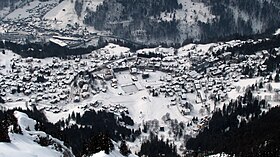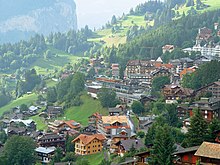Wengen BE
| BE is the abbreviation for the canton of Bern in Switzerland and is used to avoid confusion with other entries of the name Wengen . |
| Wengen | |
|---|---|
| State : |
|
| Canton : |
|
| Administrative district : | Interlaken |
| Residential municipality : | Lauterbrunnen |
| Postal code : | 3823 |
| UN / LOCODE : | CH WNG |
| Coordinates : | 637 071 / 161 752 |
| Height : | 1274 m above sea level M. |
| Area : | 36.4 km² |
| Residents: | 1078 (December 31, 2018) |
| Population density : | 30 inhabitants per km² |
| Website: | www.lauterbrunnen.ch |
|
Wengen seen from Männlichen in winter |
|
| map | |
Wengen is a village in the Bernese Oberland , which belongs to the Lauterbrunnen municipality in Switzerland . Measured by population, the place is the largest in the municipality. It is located at 1274 m above sea level. M. at the foot of the Eiger , Mönch and Jungfrau mountains , 400 meters high above the Lauterbrunnen valley .
The village is part of the tourism alliance -Jungfrau region , which includes the UNESCO - World Heritage Jungfrau-Aletsch belongs.
Wengen has been accessible from Lauterbrunnen with the Wengernalp Railway since 1893 . The village itself has no connection to the road network and is therefore almost car-free. The only vehicles are taxis, hotel vehicles, and small company vehicles. Wengen normally has 1,300 inhabitants, but more than 10,000 in the winter high season and around 5,000 in the summer holiday season.
Wengen is the «Jungfrau village» and the scene of the FIS ski Lauberhorn race . Wengen has a reformed church , built in 1953, which is a listed building. In addition to the Reformed, Wengen also has an English and a Roman Catholic church.
history
Wengen was first mentioned in 1268 as "uf Wengen". The origin of the name cannot be determined with certainty, it could be Wangen (mountain slope like a cheek) or Wengen (watery meadows).
The residents lived a secluded, simple life. Nevertheless, the great wave of plague reached the mountain village of Wengen in 1669. In addition, there were always natural disasters that the residents had to endure. In 1770 eight people lost their lives in a severe avalanche. In 1791 there was a landslide near In Gassen that cost human and animal life. In addition, foehn and autumn storms repeatedly destroyed the house and forest.
The first “tourists” passed the mountain village of Wengen in the 18th century on their way from Lauterbrunnen via Wengernalp and Kleine Scheidegg to Grindelwald . In 1859 the first inn was opened in Innerwengen. In the 1890s, the railway was built on the Wengernalp, at that time the most modern means of transport : To this day, motorized roads do not exist as access from the outside, but only within Wengen. There are a few electric vehicles on the streets of Wengen, mostly municipal vehicles and vehicles for hotel supplies that are brought up by train. The population increased from 210 (1783) to 811 (1900).
In the Second World War were here British and American airmen and Polish soldiers interned. After the Second World War, tourism picked up again. Wengen experienced a construction boom in the first decade of the 21st century. With the massive construction of holiday apartments, the urban sprawl is also advancing.
The war hole has been known and admired for centuries and is supposed to indicate whether a war is about to break out.
population
| Population development | |||||||||||||
|---|---|---|---|---|---|---|---|---|---|---|---|---|---|
| year | 1783 | 1811 | 1835 | 1900 | 1910 | 1930 | 1941 | 1960 | 1970 | 1980 | 2006 | 2014 | 2018 |
| Residents | 210 | 449 | 425 | 811 | 1016 | 996 | 974 | 1257 | 1419 | 1211 | 1257 | 1292 | 1078 |
Winter sports
Every year in January the famous Lauberhorn race takes place which consists of a men's downhill , a slalom and a combination . Alongside the Streif , on which the Hahnenkamm race takes place in Kitzbühel , the downhill run is considered the most demanding and difficult slope of the Alpine Ski World Cup and the race has the status of a classic .
The Wengernalpbahn takes you to the Allmend, Wengernalp and Kleine Scheidegg slopes . The Wengen – Männlichen cable car takes you to the Männlichen , from where you can reach the slopes to Grindelwald and Kleine Scheidegg. Most of the time you can ski both to the village of Grindelwald and to the village of Wengen.
Both Männlichen and Kleine Scheidegg can be reached in about 3 hours on foot, whereby when mountaineering on Männlichen, fog can rise unexpectedly and reduce further visibility to zero. One should not panic on the narrow and steep path. The hiking route to the Kleine Scheidegg is easier to master and is by no means steep.
politics
Wengen belongs together with Mürren , Isenfluh , Gimmelwald , Stechelberg and Lauterbrunnen to the political municipality Lauterbrunnen. The parish also includes the entire valley. Nevertheless, Wengen has remained independent in many matters (school, etc.), partly due to the connection with the main town of the valley, Lauterbrunnen, which is only possible by train. Since 2007 is mayor of the whole valley from Lauterbrunnen, as well as the parish president.
job
People from all over the world work in Wengen. The majority of course work in the hospitality industry in the winter and summer seasons . In addition to the hospitality industry, the Jungfrau Railway and the Lauterbrunnen electricity company are the largest employers.
Cultural
A wide variety of cultural events take place in Wengen in the high season (summer and winter): In the Evangelical Reformed Church, orchestral concerts (chamber orchestra), organ evenings and choir concerts; Brass music concerts and guest entertainment in the tent on the ice rink (with choirs, trychlers, yodelling groups, traditional costume groups and brass music).
Mendelssohn Music Week
The first Mendelssohn Music Week took place in Wengen from August 20 to 27, 2005. After the inauguration of the Mendelssohn monument on August 4, 2004 and the subsequent concert, it was decided to hold a music week in August each year, which is dedicated to Felix Mendelssohn Bartholdy .
Wengen free puppet stage
Every year in the winter season until Easter, a detailed program of various performances can be seen in the only permanently installed puppet stage in the Bernese Oberland , while the Wengen Free Marionette Stage is on the move with its repertoire during the summer . The first public performance took place on January 14, 2002. Since then, the Wengen Free Marionette Stage has played legends and stories from the Bernese Oberland and fairy tales from all over the world in a wide variety of performances at home and abroad .
Chästeilet
Every year on the Sunday after the federal Thanks, Repentance and Prayer Day takes place on the Chästeilet . This occasion has now established itself as the second largest event after the Lauberhorn races .
Sports events
In addition to the Lauberhorn race , Wengen is a highlight of the route at the Jungfrau Marathon every September , where thousands of spectators cheer on the approximately 4,000 participants in the 42 km run.
Club life
Many clubs have established themselves in the mountain regions of Switzerland. The following are active in Wengen: a women's club , a trychler club , a music society, a men's choir , a yodelling group , a folk dance group , the children's and youth club, the library club , a hockey club , a ski club , which celebrated its 100th anniversary in 2004, the DHO ( Downhill only, an English ski club), the tourist association, a running club, and a Scottish (CCWengen) and a wengen curling club (CC Jungfrau).
Well-known Wengener
- Heinz von Allmen , successful skier
- Oskar von Allmen , classical philologist
- René Berthod , Swiss champion downhill 1974
- Karl Molitor , Olympic silver and bronze medal 1948
- Fred Rubi , ski racer and politician
- Hans Schlunegger , ski racer and mountain guide
- Hedy Schlunegger , Olympic champion 1948
- Stefan Zürcher , film producer
- Ryan Regez , ski crosser
Transport links
From Interlaken Ost you take the Berner Oberland-Bahnen (BOB) to Lauterbrunnen, from there with the Wengernalpbahn (WAB) to Wengen. The place can also be reached on a footpath from Lauterbrunnen (3.5 kilometers). It is also possible to continue via Wengernalp , Kleine Scheidegg to Grindelwald , from where you can take the BOB to Interlaken Ost.
There are only class 5 paths (field, forest and bicycle paths) that lead from the valley to Wengen. Which are not winter-safe and are also not approved for private, motorized traffic.
Natural hazards
The region has suffered several avalanches . In the avalanche winter of 1999 , 2 people were killed in Café Oberland. The school was canceled for a week and the Wengernalp Railway had to shut down for a day. At the beginning of February 2003 the situation was the same as in 1999. The avalanche commission blocked individual streets and slopes. The situation relaxed after a few days, there was damage to the railway tracks and the forest. In 2007 a major avalanche control project was completed on the Männlichen .
In the week of August 22, 2005 in Wengen, due to two minor landslides, the power went out for two days, and both landline and mobile telephony no longer worked, which was an enormous challenge for the disaster organization. The only functioning means of communication was the radio system of the canton police in Bern, which put a relay station into operation on the Männlichen. Communication with the local fire brigade could thus be ensured. Apart from that, Wengen was completely cut off from the environment. A helicopter bridge flew out primarily tourists.
In the same year, a flood destroyed the valley floor in the direction of Interlaken. The hurricane Lothar taught 1,999 major damage to the trees.
photos
Valley station of the Wengen – Männlichen cable car , ice rink
- Wengen in summer
Wengen, the Männlichen and the Tschuggen
Individual evidence
- ↑ Swisstopo: Wengen on the national map. In: map.geo.admin.ch. Swisstopo, January 18, 2020, accessed on January 18, 2020 (German).












